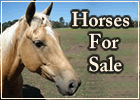

Hind Control
Here are some suggestions if a horse is not moving off your light thumb:
- Make sure your thumb never gets heavy. You should never apply more pressure than you can push on your eyeball.
- Make sure you place your thumb in the same spot every time - bottom of the last rib where your calf will swing back and touch from the mounted position. Don't be too high, too far forward on the ribs or too far back in the flank.
- Stand facing the ribs and use your forward thumb (left thumb on the horse's left side and your right thumb on the horse's right side). Have most of the slack out of the lead rope with the rope running across your forward hand and into your back hand. (If you are standing on the horse's left side you will be using your left thumb, forward hand, with the lead rope running across your left hand and going on to your right hand, back hand.) Your back hand will be holding the lead rope about 14 inches from the tail end.
- Place your forward hand thumb on the spot on the horse's side. Look at that spot and concentrate on the horse moving away from your thumb. After about 3 seconds if the horse has not moved off your light thumb, do not press harder or poke. With a deliberate motion lift your back hand to your shoulder height to show the tail of the rope, pause there for a second then flip the rope over your shoulder to smack your back, pause there for a second then flip the rope directly down onto the horse's rump at the point of the hip. By doing these steps in a very deliberate sequence the tail of the rope becomes the support cue for the light thumb. The primary cue, the thumb, never gets harder or heavier. The rope is the support cue that tells the horse he should have listened to the thumb when he had the chance. Pretty soon the horse will learn to move off the light thumb in order to avoid the rope, then you won't need the rope anymore because the horse has decided the light thumb is serious.
- Make sure you release the thumb the instant the horse moves the hind over. If the horse just backs up, leave your thumb there until he actually steps over. If the horse moves forward give a bump rearward with the lead rope to shut the front door and start over with the thumb cue.
We want no forward motion and one step moving over with each hind foot. At this point he does not have to cross the back feet over. We'll ask for that in disengaging.

Ed Dabney is an internationally acclaimed clinician, presenting horsemanship and riding clinics all over the US and in Europe. In 2007, Ed was named Champion of the East Coast Trainer Challenge Series by Equine Extravaganza. Ed was honored to have been selected by the University of Georgia to teach their senior level Young Horse Training course.
His training articles have appeared in many major national magazines. Ed produces instructional videos and the “Gentle Horsemanship” TV program which has been seen on RFD-TV.
Ed's blending of natural horsemanship and classical equitation has made an indelible mark with students all across the United States and now also in Europe, drawing the attention of serious riders searching for the lightest touch and the deepest connection with their horses irrespective of breed or discipline.


